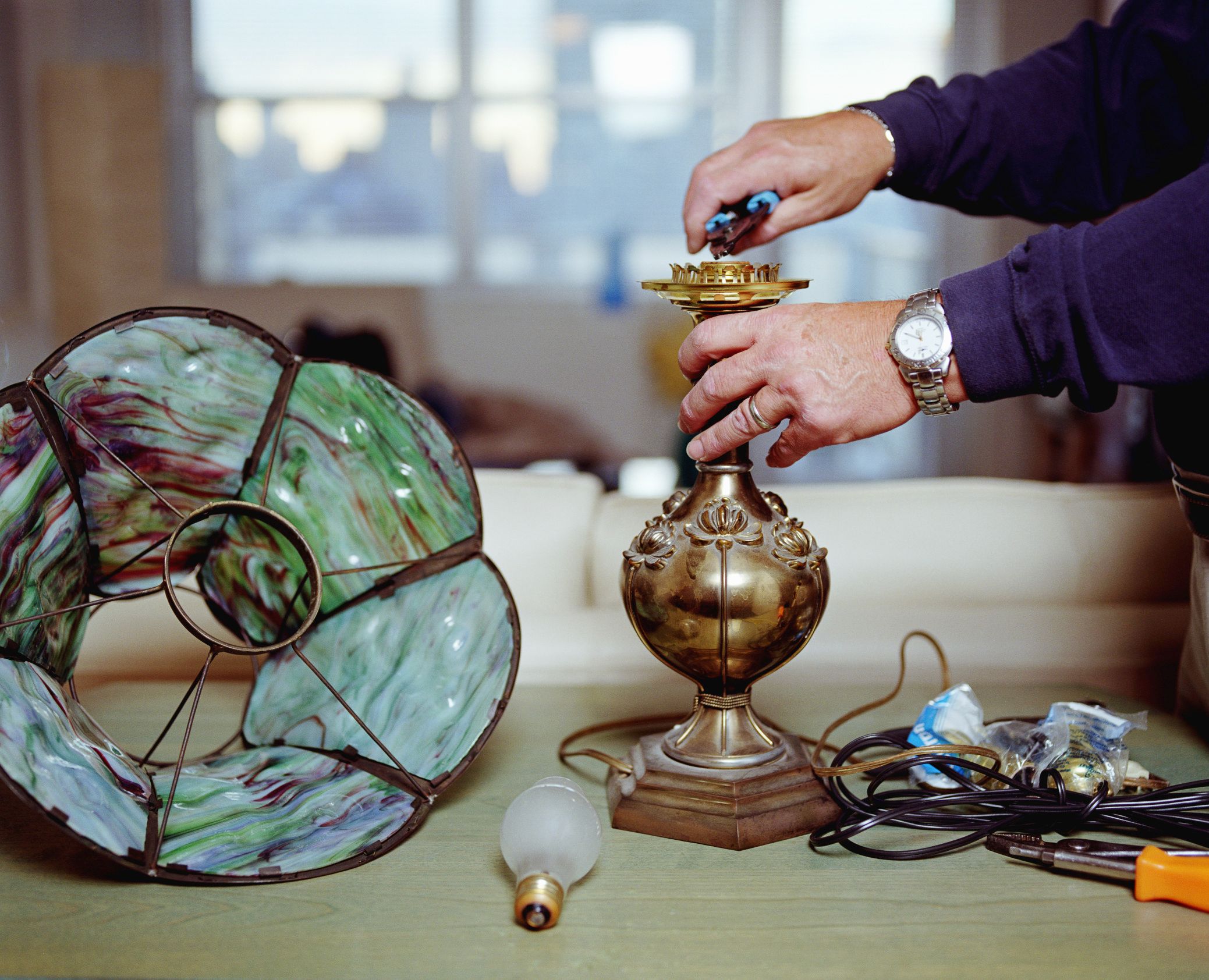Rewiring a lamp is a basic process that doesn’t require extensive electrical know-how. Whether you’re dealing with a frayed cord or a faulty switch, or if you simply want to update an antique find, knowing how to rewire a lamp can save money and preserve cherished decor.
Safety Precautions When Rewiring a Lamp
Safety should be your top priority when working with electrical components. Before starting any rewiring project, ensure the lamp is completely unplugged from any power source.
Set up your workspace in a well-lit, dry area free from potential hazards like flammable materials or clutter. Good lighting is essential for seeing small components clearly, and a dry workspace prevents the risk of electrical shock.
Use tools with insulated handles to minimize the risk of electrical shock and wear protective gear, such as safety glasses to protect your eyes from debris and rubber-soled shoes to reduce the risk of grounding yourself.
Tools and Materials for Lamp Rewiring
To rewire a lamp effectively, you’ll need the following tools:
- Multimeter (optional, for testing connections)
- Needle-nose pliers
- Replacement cord
- Screwdriver
- Wire stripper
Step-by-Step Process To Rewire a Lamp
Follow these steps carefully to ensure a safe and successful rewiring job. And remember: Always unplug the lamp before attempting any repairs.
Step 1: Gather Materials
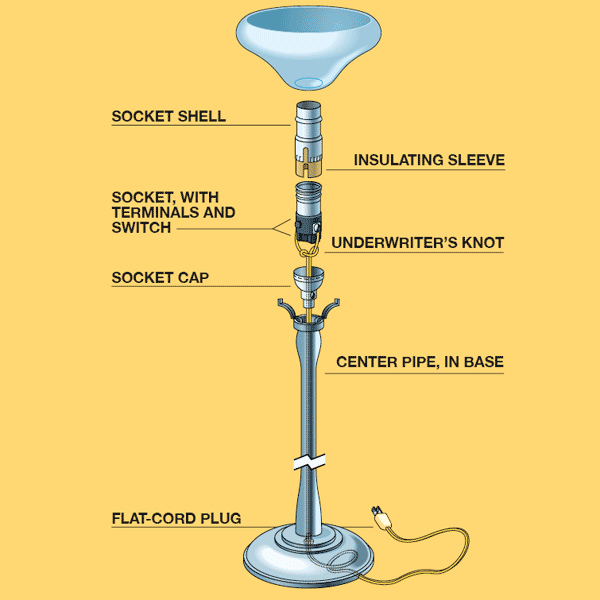
Take the lamp you hope to rewire to a hardware store to determine what type of cord and plug it requires. An electrical cord may be flat or round. A flat cord will take a clamp-style flat-cord plug, while a round cord will require a two-prong round-cord plug.
A socket is composed of several parts: an outer metal shell; an insulating sleeve; the threaded socket with its switch and two screw terminals (one silver, one brass) to which the two wires inside the cord attach; and an insulated cap, which protects the terminals.
A two-prong, round-body plug is composed of several parts: the plug body, the shell, and the cord clamp. A clamp-style flat-cord plug comes in two pieces: a core with prongs attached and a shell.
Step 2: Remove the Base
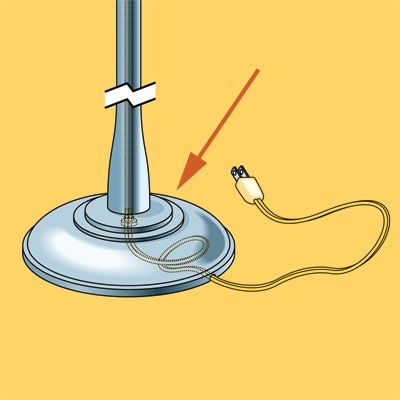
Pry the cover off the bottom of the lamp. This will reveal the nut holding the center pipe. Pull the center pipe partway out the top of the lamp, then unscrew and remove the old socket.
Step 3: Thread the New Cord
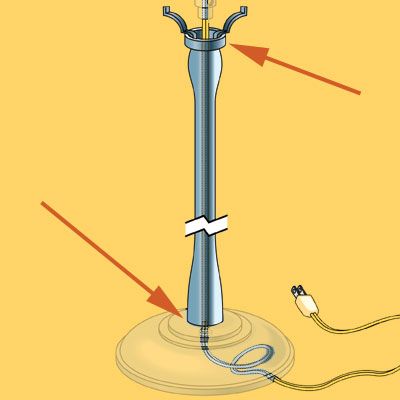
Cut off the old plug. Attach the new cord to the old cord and pull both through the pipe; snip off the old cord and discard.
Step 4: Make the Wire Connections
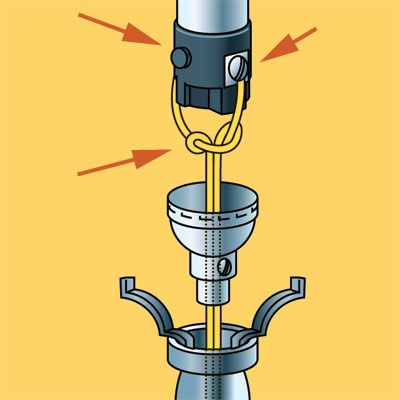
Split the top 2 inches of the cord jacket off the new cord. Strip 1/2-inch of insulation off the wire ends and form the exposed wire ends into loops. One wire end is “hot,” and the other wire – which is ridged – is considered “neutral.”
Screw in the new socket and tie an underwriter’s knot between the socket and cap. Hook the hot wire around the brass terminal and the neutral wire around the silver terminal. Tighten the screws and slip the insulating sleeve and outer metal shell over the socket and switch.
Step 5: Reattach the Base and Connect the Plug
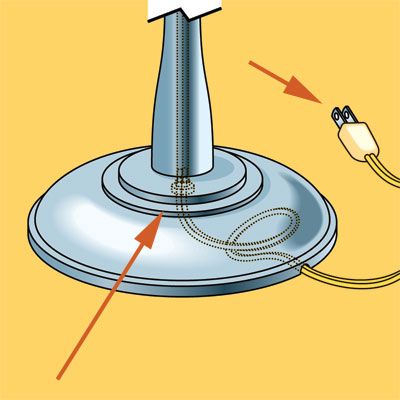
Tighten the nut around the center pipe and re-attach the base. You can cover the base with a new piece of felt to prevent the lamp from scratching the floor.
To wire a two-prong round-cord plug, pry out the body, feed the cord into the shell, and strip ¾-inch of insulation off the wire ends after splitting the bottom 1 1/4 inches of cord. Tie the wires into an underwriter’s knot. Then twist the wire ends clockwise and connect to the plug screws. Snap the plug body into the shell and tighten the clamp.
For a clamp-style, flat-cord plug like the one pictured above, pinch the prongs to release the plug core. Feed the blunt end of the flat wire through the hole in the bottom of the shell, inserting it so that the ridged, neutral wire connects to the wider prong. Squeeze the prongs together and re-insert the core in the shell.
Troubleshooting Common Issues
Even with careful rewiring, you may encounter some challenges. Here are solutions to common problems you might face during or after rewiring your lamp.
Corroded Parts
If you encounter corroded parts during disassembly:
- Use a wire brush to gently clean metal surfaces.
- Apply a small amount of electrical contact cleaner.
- Replace severely corroded parts to ensure proper function and safety.
Switch Problems
If the lamp doesn’t turn on after rewiring:
- Double-check all connections for tightness.
- Ensure the bulb is functional and properly seated.
- Test the switch with a multimeter for continuity.
- Replace the switch if it’s faulty.
If you’re unsure about any step in the process or encounter persistent issues, it’s best to consult a professional electrician.
